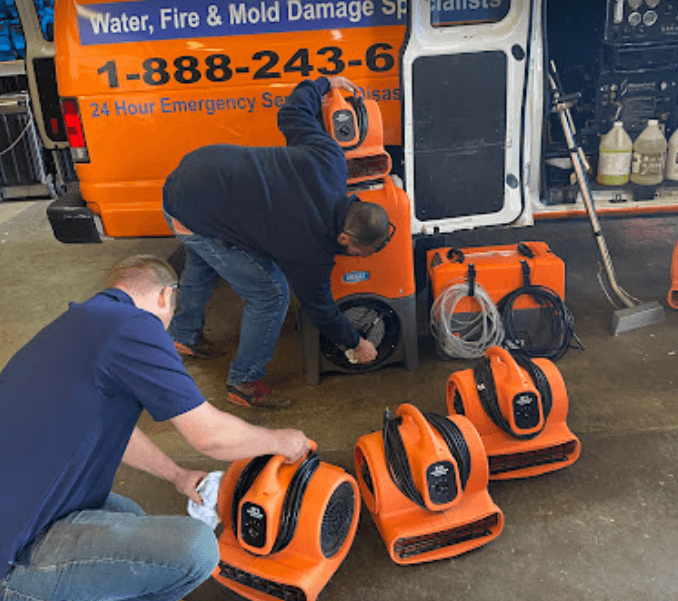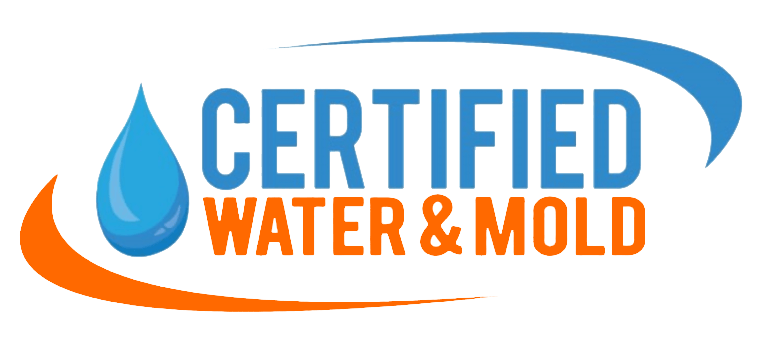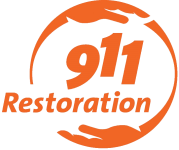Certified Water & Mold Restoration, LLC

CONTACT US
- 2021 B East Spruce Circle Olathe, KS 66062.
- 816-835-4959
- mike@cwmrestoration.com
BUISNESS LISTINGS
Drying Techniques for Water Damage
Natural Air Movement
• Open all windows and doors to encourage airflow and speed up drying.
• Open all cabinet and closet doors to ensure air circulation to all areas.
Mechanical Air Movement
• Use fans to boost airflow and help dry the affected area more quickly. High-powered fans are best.
• Rent or purchase fans specifically designed for flood damage restoration.
Dehumidification
• Dehumidifiers remove water vapor from the air, which can help dry even the most humid rooms.
• Place dehumidifiers in the affected area and run them continuously until the moisture level is reduced.
Water Extraction
• If there is standing water, use a sump pump to remove it as quickly as possible.
• Wet/dry shop vacuums can also be used to remove water from carpets, furniture, and other textiles.
Drying Sodden Items
• Move sodden items, such as rugs and furniture, outside in direct sunlight to dry.
• Place valuable items, such as books and photos, in plastic bags and freeze them to halt further damage and prevent mold growth.
• Use desiccants, such as silica gel or clay, to absorb moisture from wet items.
Advanced Drying Techniques
Professional water damage restoration services use a variety of advanced drying techniques, including:
o Suction drying: This method uses a vacuum to remove water from wet materials.
o Pressure drying: This method uses high-pressure air to dry layered structures.
o Push-pull drying: This method uses fans to circulate air in and out of the affected area to remove moisture.
o Low-pressure fans and dehumidifiers: This combination can be used to dry insulation behind walls and floors.
o Wrapping the affected area in plastic: This can be used to accelerate drying in localized areas.
If you are unsure how to dry water damage in your home, it is best to contact a professional water damage restoration company. They have the experience and equipment to dry your home quickly and effectively, preventing mold growth and further damage.
Natural Air Movement
• Open all windows and doors to encourage airflow and speed up drying.
• Open all cabinet and closet doors to ensure air circulation to all areas.
Mechanical Air Movement
• Use fans to boost airflow and help dry the affected area more quickly. High-powered fans are best.
• Rent or purchase fans specifically designed for flood damage restoration.
Dehumidification
• Dehumidifiers remove water vapor from the air, which can help dry even the most humid rooms.
• Place dehumidifiers in the affected area and run them continuously until the moisture level is reduced.
Water Extraction
• If there is standing water, use a sump pump to remove it as quickly as possible.
• Wet/dry shop vacuums can also be used to remove water from carpets, furniture, and other textiles.
Drying Sodden Items
• Move sodden items, such as rugs and furniture, outside in direct sunlight to dry.
• Place valuable items, such as books and photos, in plastic bags and freeze them to halt further damage and prevent mold growth.
• Use desiccants, such as silica gel or clay, to absorb moisture from wet items.
Advanced Drying Techniques
Professional water damage restoration services use a variety of advanced drying techniques, including:
o Suction drying: This method uses a vacuum to remove water from wet materials.
o Pressure drying: This method uses high-pressure air to dry layered structures.
o Push-pull drying: This method uses fans to circulate air in and out of the affected area to remove moisture.
o Low-pressure fans and dehumidifiers: This combination can be used to dry insulation behind walls and floors.
o Wrapping the affected area in plastic: This can be used to accelerate drying in localized areas.
If you are unsure how to dry water damage in your home, it is best to contact a professional water damage restoration company. They have the experience and equipment to dry your home quickly and effectively, preventing mold growth and further damage.
Natural Air Movement
• Open all windows and doors to encourage airflow and speed up drying.
• Open all cabinet and closet doors to ensure air circulation to all areas.
Mechanical Air Movement
• Use fans to boost airflow and help dry the affected area more quickly. High-powered fans are best.
• Rent or purchase fans specifically designed for flood damage restoration.
Dehumidification
• Dehumidifiers remove water vapor from the air, which can help dry even the most humid rooms.
• Place dehumidifiers in the affected area and run them continuously until the moisture level is reduced.
Water Extraction
• If there is standing water, use a sump pump to remove it as quickly as possible.
• Wet/dry shop vacuums can also be used to remove water from carpets, furniture, and other textiles.
Drying Sodden Items
• Move sodden items, such as rugs and furniture, outside in direct sunlight to dry.
• Place valuable items, such as books and photos, in plastic bags and freeze them to halt further damage and prevent mold growth.
• Use desiccants, such as silica gel or clay, to absorb moisture from wet items.
Advanced Drying Techniques
Professional water damage restoration services use a variety of advanced drying techniques, including:
o Suction drying: This method uses a vacuum to remove water from wet materials.
o Pressure drying: This method uses high-pressure air to dry layered structures.
o Push-pull drying: This method uses fans to circulate air in and out of the affected area to remove moisture.
o Low-pressure fans and dehumidifiers: This combination can be used to dry insulation behind walls and floors.
o Wrapping the affected area in plastic: This can be used to accelerate drying in localized areas.
If you are unsure how to dry water damage in your home, it is best to contact a professional water damage restoration company. They have the experience and equipment to dry your home quickly and effectively, preventing mold growth and further damage.
Natural Air Movement
• Open all windows and doors to encourage airflow and speed up drying.
• Open all cabinet and closet doors to ensure air circulation to all areas.
Mechanical Air Movement
• Use fans to boost airflow and help dry the affected area more quickly. High-powered fans are best.
• Rent or purchase fans specifically designed for flood damage restoration.
Dehumidification
• Dehumidifiers remove water vapor from the air, which can help dry even the most humid rooms.
• Place dehumidifiers in the affected area and run them continuously until the moisture level is reduced.
Water Extraction
• If there is standing water, use a sump pump to remove it as quickly as possible.
• Wet/dry shop vacuums can also be used to remove water from carpets, furniture, and other textiles.
Drying Sodden Items
• Move sodden items, such as rugs and furniture, outside in direct sunlight to dry.
• Place valuable items, such as books and photos, in plastic bags and freeze them to halt further damage and prevent mold growth.
• Use desiccants, such as silica gel or clay, to absorb moisture from wet items.
Advanced Drying Techniques
Professional water damage restoration services use a variety of advanced drying techniques, including:
o Suction drying: This method uses a vacuum to remove water from wet materials.
o Pressure drying: This method uses high-pressure air to dry layered structures.
o Push-pull drying: This method uses fans to circulate air in and out of the affected area to remove moisture.
o Low-pressure fans and dehumidifiers: This combination can be used to dry insulation behind walls and floors.
o Wrapping the affected area in plastic: This can be used to accelerate drying in localized areas.
If you are unsure how to dry water damage in your home, it is best to contact a professional water damage restoration company. They have the experience and equipment to dry your home quickly and effectively, preventing mold growth and further damage.
Natural Air Movement
• Open all windows and doors to encourage airflow and speed up drying.
• Open all cabinet and closet doors to ensure air circulation to all areas.
Mechanical Air Movement
• Use fans to boost airflow and help dry the affected area more quickly. High-powered fans are best.
• Rent or purchase fans specifically designed for flood damage restoration.
Dehumidification
• Dehumidifiers remove water vapor from the air, which can help dry even the most humid rooms.
• Place dehumidifiers in the affected area and run them continuously until the moisture level is reduced.
Water Extraction
• If there is standing water, use a sump pump to remove it as quickly as possible.
• Wet/dry shop vacuums can also be used to remove water from carpets, furniture, and other textiles.
Drying Sodden Items
• Move sodden items, such as rugs and furniture, outside in direct sunlight to dry.
• Place valuable items, such as books and photos, in plastic bags and freeze them to halt further damage and prevent mold growth.
• Use desiccants, such as silica gel or clay, to absorb moisture from wet items.
Advanced Drying Techniques
Professional water damage restoration services use a variety of advanced drying techniques, including:
o Suction drying: This method uses a vacuum to remove water from wet materials.
o Pressure drying: This method uses high-pressure air to dry layered structures.
o Push-pull drying: This method uses fans to circulate air in and out of the affected area to remove moisture.
o Low-pressure fans and dehumidifiers: This combination can be used to dry insulation behind walls and floors.
o Wrapping the affected area in plastic: This can be used to accelerate drying in localized areas.
If you are unsure how to dry water damage in your home, it is best to contact a professional water damage restoration company. They have the experience and equipment to dry your home quickly and effectively, preventing mold growth and further damage.
Natural Air Movement
• Open all windows and doors to encourage airflow and speed up drying.
• Open all cabinet and closet doors to ensure air circulation to all areas.
Mechanical Air Movement
• Use fans to boost airflow and help dry the affected area more quickly. High-powered fans are best.
• Rent or purchase fans specifically designed for flood damage restoration.
Dehumidification
• Dehumidifiers remove water vapor from the air, which can help dry even the most humid rooms.
• Place dehumidifiers in the affected area and run them continuously until the moisture level is reduced.
Water Extraction
• If there is standing water, use a sump pump to remove it as quickly as possible.
• Wet/dry shop vacuums can also be used to remove water from carpets, furniture, and other textiles.
Drying Sodden Items
• Move sodden items, such as rugs and furniture, outside in direct sunlight to dry.
• Place valuable items, such as books and photos, in plastic bags and freeze them to halt further damage and prevent mold growth.
• Use desiccants, such as silica gel or clay, to absorb moisture from wet items.
Advanced Drying Techniques
Professional water damage restoration services use a variety of advanced drying techniques, including:
o Suction drying: This method uses a vacuum to remove water from wet materials.
o Pressure drying: This method uses high-pressure air to dry layered structures.
o Push-pull drying: This method uses fans to circulate air in and out of the affected area to remove moisture.
o Low-pressure fans and dehumidifiers: This combination can be used to dry insulation behind walls and floors.
o Wrapping the affected area in plastic: This can be used to accelerate drying in localized areas.
If you are unsure how to dry water damage in your home, it is best to contact a professional water damage restoration company. They have the experience and equipment to dry your home quickly and effectively, preventing mold growth and further damage.
Natural Air Movement
• Open all windows and doors to encourage airflow and speed up drying.
• Open all cabinet and closet doors to ensure air circulation to all areas.
Mechanical Air Movement
• Use fans to boost airflow and help dry the affected area more quickly. High-powered fans are best.
• Rent or purchase fans specifically designed for flood damage restoration.
Dehumidification
• Dehumidifiers remove water vapor from the air, which can help dry even the most humid rooms.
• Place dehumidifiers in the affected area and run them continuously until the moisture level is reduced.
Water Extraction
• If there is standing water, use a sump pump to remove it as quickly as possible.
• Wet/dry shop vacuums can also be used to remove water from carpets, furniture, and other textiles.
Drying Sodden Items
• Move sodden items, such as rugs and furniture, outside in direct sunlight to dry.
• Place valuable items, such as books and photos, in plastic bags and freeze them to halt further damage and prevent mold growth.
• Use desiccants, such as silica gel or clay, to absorb moisture from wet items.
Advanced Drying Techniques
Professional water damage restoration services use a variety of advanced drying techniques, including:
o Suction drying: This method uses a vacuum to remove water from wet materials.
o Pressure drying: This method uses high-pressure air to dry layered structures.
o Push-pull drying: This method uses fans to circulate air in and out of the affected area to remove moisture.
o Low-pressure fans and dehumidifiers: This combination can be used to dry insulation behind walls and floors.
o Wrapping the affected area in plastic: This can be used to accelerate drying in localized areas.
If you are unsure how to dry water damage in your home, it is best to contact a professional water damage restoration company. They have the experience and equipment to dry your home quickly and effectively, preventing mold growth and further damage.







